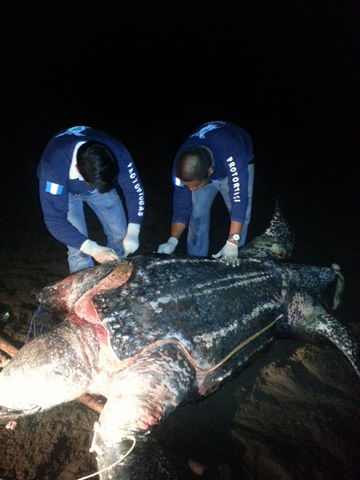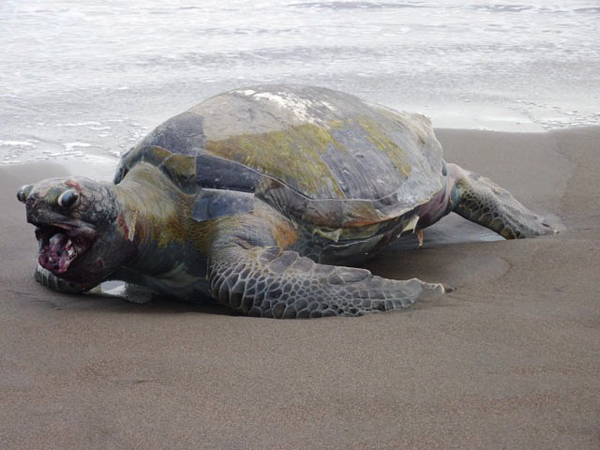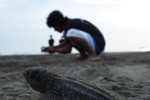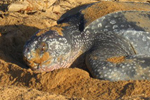An assortment of marine animals and birds reside along the black volcanic sand beaches of Guatemala’s Pacific coast, but lately both residents and visitors on the southeast beaches of the country have observed a tragic event – the stranding of dead sea turtles.
Eighty dead sea turtles have been recorded since the first week of July on the beaches of La Barrona, Las Lisas, Chapeton and Hawaii according to a statement released by the Wildlife Rescue and Conservation Association (ARCAS), a Guatemalan non-profit organization formed by citizens in 1989.
“The entire coast has historically been a significant nesting area for olive ridley and leatherback sea turtles,” Colum Muccio, ARCAS administrative director, told mongabay.com. While not known to nest in Guatemala, east pacific green turtles forage in estuaries and mangrove waterways along the Pacific coast.
Tucked between Mexico and El Salvador, the 250 kilometers of coast is divided by 14 river mouths and peppered with beautiful mangrove wetlands and lagoons. In 1993, ARCAS initiated conservation activities in the Hawaii area with hopes of counteracting threats to leatherback and olive ridley sea turtle populations. The leatherback sea turtle (Dermochelys coriacea) is currently listed as Critically Endangered by the IUCN Red List, while the olive ridley (Lepidochelys olivacea) is listed as Vulnerable.
 The olive ridley was encountered with what appears to be a machete wound to the head. Photo courtesy of ARCAS. |
“We manage two of the 24 hatcheries on the Pacific coast of Guatemala, and carry out research and advocacy for sea turtle conservation,” Muccio said.
According to the statement, nearby residents are worried because sea turtles are a valuable resource. Not only do the sea turtles draw tourists to the coast, but, despite their endangered status, the eggs are also a source of income.
“Sea turtle conservation efforts in Guatemala rely on the use of hatcheries, which are managed as part of a quasi-legal egg harvest,” Muccio said. “Villagers are permitted to collect eggs that are deposited on Guatemalan beaches on the condition that 20 percent of each clutch is donated to a nearby hatchery.”
The system was initiated in the mid 1980s to promote the sustainable use of sea turtle eggs, Muccio continued. The operating hatcheries along the Pacific coastline function at various levels based on financial resources of the administering organization.
Muccio states many hatcheries are underfunded, short-staffed and operating with limited scientific knowledge. Several hatcheries do not carry out beach monitoring or research activities, contributing to the deficit in accurate nesting and stranding data.
“Many projects are lacking in the key elements necessary for the present community-based conservation system to function successfully,” Muccio said.
In addition to egg harvesting, one of the main threats to sea turtles on the Pacific coast of Guatemala is fisheries by-catch. The statement notes that the appearance of dead turtles on the beach coincides with the presence of shrimp trawlers in waters off these beaches.
 Doctors Alfaro and Perez of Protortugas initiating the necropsy. No cause of death was determined, but biopsies were taken and will be analyzed. Photo courtesy of ARCAS. |
“I don’t think it’s a coincidence that when shrimp trawlers appear in the ocean that we begin having stranded turtles,” Muccio said.
Although Guatemalan trawlers are required to use turtle excluder devices (TEDs), Muccio said that enforcement is difficult and fines are very light.
“We are currently working on instituting a ban on bottom trawling,” said Muccio. “This has recently been done in Belize, Costa Rica and Ecuador and El Salvador doesn’t allow them closer than 3 miles from shore.”
Leading marine turtle conservationists and researchers presented a petition to the government of Guatemala expressing their concern. According to the statement, the petition requests that the government take action to counter the mortality of sea turtles, including the monitoring of shrimp trawlers to establish the impact on marine turtle populations.
“Sea turtles are also very much part of the identity of the local culture and local communities often take pride in their hatcheries and their contributions to save the sea turtle,” Muccio said.

Among the stranded sea turtles were leatherbacks and Pacific green turtles, two species that are critically endangered. This green turtle documented by Akazul volunteers in La Barrona had its lower jaw removed, possibly to recover a hook. Photo courtesy of ARCAS.
Related articles
Suspects arrested in Costa Rican sea turtle conservationist’s murder
(08/03/2013) Eight suspects were arrested during early-morning raids Wednesday in the murder of Costa Rican sea turtle conservationist Jairo Mora.
Costa Rican environmentalist pays ultimate price for his dedication to sea turtles

(06/10/2013) On the evening of May 30th, 26-year-old Jairo Mora Sandoval was murdered on Moin beach near Limón, Costa Rica, the very stretch of sand where he courageously monitored sea turtle nests for years even as risks from poachers rose, including threats at gunpoint. A dedicated conservationist, Sandoval was kidnapped along with four women volunteers (three Americans and one from Spain) while driving along the beach looking for nesting sea turtles. Sandoval was separated from the women—who eventually escaped their captors—but the young Costa Rican was stripped naked, bound, and viciously beaten. Police found him the next day, face-down and handcuffed in the sand; Sandoval died of asphyxiation.
Leatherback sea turtles suffer 78 percent decline at critical nesting sites in Pacific

(02/27/2013) The world’s largest sea turtle, the leatherback (Dermochelys coriacea), is vanishing from its most important nesting sites in the western Pacific, according to a new study in Ecosphere. Scientists found that leatherback turtle nests have dropped by 78 percent in less than 30 years in the Bird’s Head Peninsula on the island of New Guinea. Worryingly, these beaches account for three-fourths of the western Pacific’s distinct leatherback population; globally the leatherback is listed as Critically Endangered by the IUCN Red List, the highest rating before extinction.